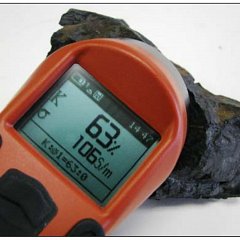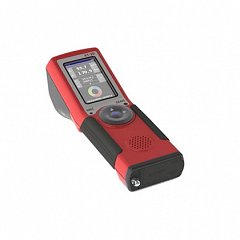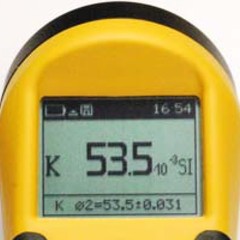Handheld Material Property Meters
What’s the difference between the KT-10 and KT-20?
The KT-10 is a handheld magnetic susceptibility and conductivity meter, which can be used to solely measure magnetic susceptibility or conductivity, or to measure both simultaneously. The KT-10 has a 10 kHz operating frequency and comes with a fixed sensor available in either a circular or rectangular design.
The KT-20 is a modular physical property measuring system with interchangeable sensors, which can be used to solely measure magnetic susceptibility or conductivity, to measure both simultaneously, and to measure IP/resistivity and density. A variety of interchangeable sensors are available in different shapes (circular, rectangular, and curved) and frequencies (1 kHz, 10 kHz, and 100 kHz) to facilitate a wide range of applications.
What are the benefits of using different shaped sensors?
The KT-10 and KT-20 have different sensor shapes, as shown below, to adapt the instruments to measure a variety of samples. Choosing the ideal sensor shape will ensure a better measurement.

Circular sensors have a diameter of 65mm for the KT-10 and 66 mm for the KT-20 and are ideal for measuring large, flat samples. They feature a pin mode for measuring samples with uneven surfaces, such as outcrop or mine walls. The pin mode is included with all circular design KT-10 models and the 10 kHz Single-Frequency Circular Sensor for the KT-20.
Rectangular sensors have dimensions of 65mm x 32mm for the KT-10 and 65mm x 38mm for the KT-20. This narrower design is ideal for measuring small, flat samples or split drill core.
Curved sensors are for measuring full cylindrical core samples. There are 10 kHz and 100 kHz curved sensors available in dedicated BQ, NQ, HQ, or PQ diameters. Their curved shape allows users to achieve a higher sensitivity for magnetic susceptibility or conductivity, while producing consistent, repeatable measurements.
What are the benefits of using different frequencies?
Below are the operating frequencies available for the KT-10 and KT-20 and the parameters they are beneficial for:

The 1 kHz frequency is helpful for measuring magnetic susceptibility on conductive samples. Measuring magnetic susceptibility in a low frequency reduces the impact of conductivity on the measurement, producing more accurate results on conductive samples, like graphite. This frequency has a lower sensitivity for measuring magnetic susceptibility (1 x 10-5 SI) and is not recommended for measuring conductivity.
The 10 kHz frequency is ideal for measuring both magnetic susceptibility and conductivity simultaneously. It is commonly used for measuring magnetic susceptibility and conductivity as it provides good sensitivity for both methods.
The 100 kHz frequency provides the highest sensitivity for conductivity measurements in low ranges, however is not suitable for measuring magnetic susceptibility.



